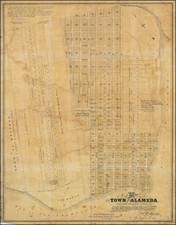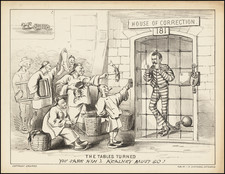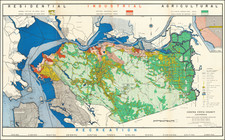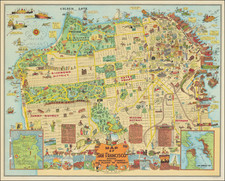Lithographic View of the Crystal Springs Reservoir by an Important African American Lithographer
Well executed lithograph of the Ranch and Residence of Michael Casey, situated above the original Crystal Springs Reservoir, by Grafton Taylor Brown, from Moore & De Pue's Illustrated History of San Mateo County.
G.T. Brown
Grafton Tyler Brown is perhaps the first and unquestionably the most famous African American artist and lithographer to depict California and the Pacific Coast. Born in Harrisburg, Pennsylvania, February 22, 1841, Brown moved to San Francisco at the age of 20 and learned the art of lithography from C. C. Kuchel. In 1861 and again in 1864, Brown created the two earliest bird's eye views of Virginia City. At the age of 26, he established his own firm, G.T. Brown & Co.
Brown produced skillfully illustrated bank notes, labels, and maps, and stock certificates for Wells Fargo, Levi Strauss and Co., and several mining companies. His significant lithographic production, The Illustrated History of San Mateo County (1878), featured 72 views of the county's communities and ranches. Brown traveled throughout Oregon, Washington, Idaho, Wyoming, Nevada, and British Columbia (where he settled in 1882), producing maps and illustrations, including many landscape paintings.
In 1893, Brown secured employment as a draftsman at the St. Paul, Minnesota office of the U.S. Army Corps of Engineers. Sometime during his St. Paul years he married Elberta Brown. Brown's work with the Corps of Engineers ended in December 1897, after which he worked in the civil engineering department of the city of St. Paul until 1910. He died on March 3, 1918, in Nicollet County, Minnesota, bringing to a close a rich and varied career as an artist and illustrator of the American West.
Michael Casey
In the late 1850s James Brynes established a store on the west side of Rancho Cañada de Raymundo along the Spanishtown on theSan Mateo Road. Brynes Store was a popular stop along the cross-county road frequented by daily stagecoaches and travelers.
In the 1850s, a number of Irish farmers settled in the Brynes Store-Laguna Grande area, including Michael Casey who came to the county in 1856 and owned 327-acre farm and stock ranch west of Brynes Store. Casey was an importand member of the Irish communityclustered around Brynes Store and donated a parcel of his land for the reconstruction of the Laguna Schoolhouse after it burned down in the 1870s. Casey's land apparently included coal deposits, as neighboring farmer J.G Maynard operated a coal mine on Caseys ranch in the mid-1870s.
Laguna Grande / Crystal Springs Reservoir
The original name of the southern or Upper Crystal Springs Reservoir was Laguna Grande, a natural lake first described by the Portolà Expedition of 1769, which camped at the Lake on November 5, 1769. Juan Crespí wrote:
We stopped close to a lake where there are countless ducks, geese, and so forth, in the same hollow at a half past one in the afternoon; and we have made three leagues in four hour hours and a half. Here in this hollow tracks have been encountered of large livestock, which some said were made by bears; others, by buffalo. Also a great many deer have been seen together, while the scouts aver that when they explore here, they saw whole bands of deer, and counted so many as fifty deer together in one. As we were upon the point of setting out from the spot, three very well-behaved heathens came over from the villages here, seeking us out laden with a good share of black pies and a sort of cherries that they made a present of, and they followed us along well pleased, giving us to understand we should go to their village [and] they will give us food. (A great many madroños, small and large, have been met with during these two days’ march, laden with fruits the size of so many beads off our rosaries.)
The Laguna Grande place name is also shown on the 1840s Diseño del Rancho Cañada de Raymundo and an 1856 plat of the Rancho de las Pulgas.
The first Crystal Springs Reservoir was created by an earthen dam built in 1877. Ultimately, the Spring Valley Water Company created 2 lakes.
Lower Crystal Springs Reservoir now covers the town of Crystal Springs which grew up around a little resort town of the same name, founded in mid-19th century and located just northwest of the present-day dam. The Crystal Springs Hotel tract was constructed around the 1860s, located four miles from the San Mateo train depot and along a stagecoach stop. A small group community developed in the area, including a dairy and farms. In 1875, the town of Crystal Springs lost its population and business and by 1887, the location of the town was underwater because of the dam construction.












![(Bird's-Eye View of California) San Francisco Invites You [cover title]](https://storage.googleapis.com/raremaps/img/small/92552.jpg)

![Alameda County, California. Showing The Automobile Roads and Principal Points of Interest . . . [Livermore Valley Views]](https://storage.googleapis.com/raremaps/img/small/76961.jpg)